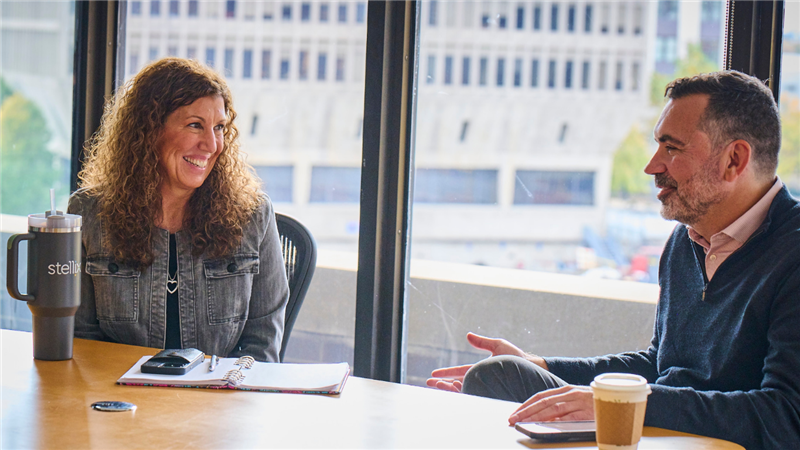
An Unprecedented Life Science Challenge
In the early days of the pandemic, NECI (now part of Stellix) played a crucial role in helping Moderna manufacture its groundbreaking mRNA vaccine.
This wasn’t just another manufacturing project. Scaling up production for an mRNA-based vaccine at this speed had never been done before. The stakes were enormous, the challenge unprecedented.
It was an all-hands-on-deck effort to tackle one of modern history's biggest global health crises. NECI’s team worked around the clock—24/7, in shifts—to bring the vaccine to market.
The result? In less than a year, the vaccine was launched—helping protect millions of people worldwide and changing the trajectory of the pandemic.
The team was in near-constant collaboration, but they worked together from the isolation of their own homes. Despite the complexity and urgency of the project, NECI’s team was fully remote, as many of us were at that time, for safety reasons. Solving problems, making critical decisions, and driving progress: it all happened without the ability to be on-site together.
At first glance, the story seems like a clear victory for remote work. If our team could accomplish something this ambitious, under extreme pressure, then surely remote teams are just as capable of collaboration and success as in-person teams.
But that takeaway is missing critical context. It doesn’t tell the whole story.
Looking Deeper: How Connectivity Was Built in the Past
The NECI team assigned to the Moderna project wasn’t just any group of remote workers. Before COVID-19 forced a shift to remote work, they had spent years working together in person.
They knew each other. They trusted each other. They understood how to talk through problems, anticipate each other’s needs, and collaborate effectively—before circumstances required them to take their work online.
So yes, they accomplished something incredible. And yes, they did it in a fully remote work environment. But their ability to succeed in that environment wasn’t an accident. It was a direct result of the foundation they had already built together as a team. A foundation that, like it or not, was built while they worked together in person.
At the risk of sounding nostalgic, I often reflect on my early days as an engineer—because I think there are some lessons to learn from that time. Back then, connection wasn’t something we had to think about—it just happened. It was built in, baked into the way we worked.
We spent hours together, not just in meetings but also in the in-between moments: grabbing lunch, chatting as we walked to the parking lot, leaning over someone’s desk to troubleshoot an issue in real time. A quick question turned into a five-minute whiteboard session. A side conversation in the hallway led to an insight that changed the course of a project.
You got to know your team—not just their skills, but their quirks, their thinking styles, their approach to challenges. You learned who worked best under pressure, who could cut through complexity, who always had a fresh perspective.
The Hybrid Work Dilemma
Today’s workplaces look very different—even compared to just five years ago. That’s certainly the case for Stellix.
Like many companies, we’ve embraced a hybrid work policy—offering people the flexibility to work remotely when needed while also recognizing the value of being physically present to build relationships and collaborate more effectively.
We know that not every task requires an office. But we also know that something is lost when teams don’t spend enough time with one another. That’s why we’ve invested in a thoughtfully designed workspace—a place meant to bring people together, encourage spontaneous interactions, spark problem-solving over coffee, and create those unexpected “magic moments” that strengthen teams.
But in a hybrid environment, those moments aren’t happening as often as they once did.
At the same time, our team itself has changed. We've said goodbye to folks who retired. We’ve welcomed a new generation of employees with fresh ideas and energy. Former colleagues who were once part of our daily lives are no longer in our break rooms. These days, anyone who joins our team is entering a world where hybrid work is the norm from day one.
The result of all this? The connections between team members have grown thinner. The reality is that we just don't know each other as well anymore.
So… What Is the Workplace of the Future?
As a leader, I'm wrestling with fundamental questions about the future of work.
On one hand, Stellix is in the business of innovation, automation, and the future. When we talk about robotics, digital twins, and Industry 4.0, it feels backward to insist that the only way forward is for everyone to sit in the same physical space.
On the other hand, Stellix is and always has been a people-driven company. Yes, we provide cutting-edge technology, but we don’t just sell it—we help customers implement, adopt, and optimize it. That involves working together to solve complex problems, share knowledge, and support innovation.
How do we design a workplace that allows people to do their best work, thrive in flexible environments, maintain work-life balance, and build meaningful connections?
I’m still trying to figure that out.
Engagement Must Be Earned
One thing is clear: Companies have to earn engagement differently now. A return-to-office mandate might boost productivity—but that’s not the type of workplace I want to build. At the same time, I’m finding that virtual relationships aren't enough to create strong bonds between teammates.
So, how can we create an environment where team members see their colleagues as real, multi-dimensional people—not just names in a Teams channel or faces on a screen? What conditions—both virtual and in-person—foster real connection?
I don’t have all the answers.
But what I do know is that moments of connection don’t occur as easily anymore. In a hybrid world, we must be intentional about making room for casual conversations, shared experiences, and real relationships. That means designing spaces (physical and virtual) and workflows that encourage connection—and just as importantly, building a culture that makes people want to engage.
I also know that getting it right is worth the effort. Because when people truly know each other—not just names and basic skills, but a deep understanding of experiences, strengths, and working styles—they are capable of amazing things.
You don't deliver a COVID-19 vaccine in record time without profound trust and understanding between team members who are willing to go to war together.
Technology is advancing faster than ever. We’re constantly looking ahead—automation, AI, digital transformation. But none of it is possible without the people behind it.
We have to keep pushing forward on this front, too. Because when we lose sight of human connection, we lose the very foundation that drives meaningful innovation.
I’d love to hear from you: What’s working for your teams? How are you fostering connection in a hybrid world?

